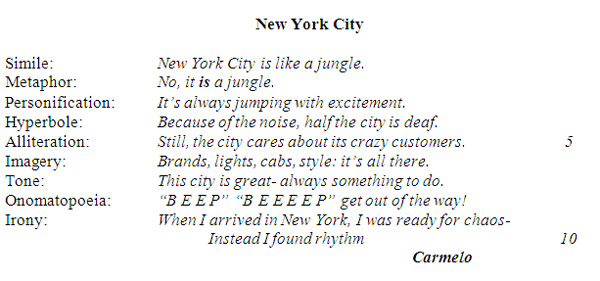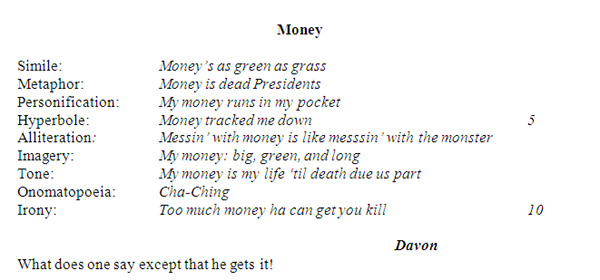Mary Lou L. Narowski
There is nothing quite like producing an awesome poem right out of the gate. This tried and true exercise will provide just that for my students. Laying the ground work to also include the illumination of poetry as sound will incentivize my students to investigate poetry as an intriguing genre, something they would balk at otherwise. The exercise will show them that they already understand what the poetic elements of sound look like and are completely comfortable using them when they write. This introductory lesson will ask my students to review the basic definitions and tenets of the poetic devices listed below, making sure that they have an understanding of these elements. As they have been exposed to some of these features in varying degrees in lower grades and have hopefully been exposed to them from the start of the school year, this shouldn't impose too much of a time restriction or the boring "
om"
I call the English class syndrome. By providing them with a graphic organizer which lists the elements and having them work with a partner to define them is one idea that can be used to acclimate them to this exercise. Another approach could be a quick jeopardy-style answer and question mini lesson. Nothing too complicated should be expected as this would only act as a turn off.
Next, I will have the class choose any person, place, thing, idea, or emotion that appeals to them. Then, writing single lines of poetry about their chosen word, employing, in each line, one element from the list of literary devices, my students will actually come to understand why word selection and sound device are so very important in verse. Each line will incorporate and represent a different poetic device and will, hopefully, show my students the richness of word variety in poetry using these devices. Perhaps, they will even recognize how sound is an integral part of most lines, woven into them as a result of knowledge of poetic device, and used effectively to express intent. This instant immersion will produce poems that students can be proud of, thus providing them with incentive to continue exploring. These samples of student work are proof of the effectiveness of this exercise. What will be new for my students is the auditory discussion of sound that follows.

The next step in the process will be to examine a student work, in this case, Carmelo's poem. They will engage in an introductory discussion and analysis of its acoustical elements within poem. To provide this direction, I would ask the following questions: what is their initial impression; do they like it; why or why not; what are the actual, literal sounds that we hear; what is the result of these physical noises; is there any type of pattern or rhythm that gives us a sense of beat; where is the alliteration and onomatopoeia and how is it expressed? I would guide them to consider his single syllable word selection in line six and ask how that line adds to the sound and meaning of the poem. Finally, I would ask how his example of irony adds to the acoustical meaning. Student input in terms of answers as well as questions will highlight our discussions. I would be delighted if a written response at the end of our discussion took on the following form:
In this poem, sound is everywhere. In the opening line we hear New York compared to a jungle which, of course, provides a cacophony of sounds with no apparent patterning. Visitors often note this very fact as they walk the streets of the City. Next, we learn of the City's movement and excitement. There is this clamor which causes half the city to be deaf, a physical reaction to intense and repeated sound. Moving on, we see the repeated use of the initial letter "c" providing alliteration. Line six is comprised of single syllable words giving us a sense of quickness so present in New York. There is obvious sound in line nine not only in the word meaning but also in the actual sound of the words "beep" "beeep." Finally, we hear the irony of the comparison of New York to a jungle as the writer expected to find jungle's chaos but instead found the City's rhythm. If a student could so effectively incorporate all these devices into one poem and then be guided to recognize them, it would certainly motivate him to continue his investigation into poetry as a serious and enjoyable genre, one that he now has confidence in as a writer. If this introductory analysis can be evoked then a more comprehensive analysis can be used with other poems, all with supportive questioning outlined below
in
the
How We Look at Poetry Questions.
This second example is my shining one. This is the student who never put pen to paper for me. Never. He sat quietly all year and then produced this poem. Patience!
